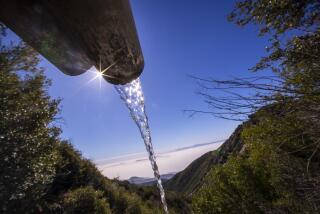H2 0: The Nose Knows : Metropolitan Water District’s Tasters Sniff Trouble Before It Hits the Tap
- Share via
Stuart W. Krasner carefully decanted the pale liquid, warmed precisely to 25 degrees centigrade, into a plastic cup. Swirling the bright, unassuming beverage to let the volatile aromas build, he gently lifted the cup’s glass lid and sniffed deeply.
Then it was down the hatch, slurping loudly to check for flavor, aroma and maybe even subtle hints of the African clawed frog. One never knows, and in his six years Krasner has sniffed out a lot.
Scribbling notes in silence, he and four other chemists at the table in the meticulously air-controlled room nibbled unsalted crackers before moving on to the final bottle and a consensus taste verdict: “fishy, cardboardy and grassy.”
For Californians, this stuff has built fortunes and cities, but chugging it doesn’t leave Krasner staggering about the laboratory. It’s only good old tap water, the drink of millions. And in this case it was raw reservoir water, destined after treatment for the faucets of more than half of the county’s homes and about 13 million other Southern Californians.
Checking Up on Machine Tests
Five mornings a week the energetic Krasner, 38, leads a panel of tasters who swig water taken to the Metropolitan Water District’s water quality laboratory in La Verne from 20 checkpoints in six Southern California counties. The Flavor Profile Panel’s tasting job is to make certain that MWD’s 200 separate chemical and machine tests of 100,000 samples a year are actually assuring a water taste that people want to drink.
Krasner, one of the laboratory’s senior chemists, will put his team’s highly honed palates up against any $200,000 gas chromatograph mass spectrometer. “That’s still not as good as most of our panelists,” he said.
Indeed, the panelists can take a slurp and readily tell whether the water comes from Pyramid Lake by the Tehachapi Mountains, Lake Skinner near the San Jacinto Mountains or the Colorado River.
“The nose and palate are a highly specialized piece of equipment perfected through long periods of evolution,” said panel member Warren Schimpf, 44, a senior chemist at the laboratory with a doctorate from the University of Michigan. “You just can’t program a computer to do that.”
“They are much faster than even our best mechanical services,” said Bob Gomperz, a spokesman for MWD.
And in an emergency, speed and a light suitcase can take panelists where no machine could go.
“When we have a taste or odor emergency at one of our reservoirs or treatment plants, they’ve been known to stay on site around the clock for days until the problem is solved,” Gomperz said.
Panelist Pat Rottler, 44, once found herself bobbing on a boat at Lake Mathews in Riverside County to answer a taste emergency call: rotten, fishy smells. As a team of scuba divers gathered samples at different lake levels beneath her, Rottler calmly slurped the test tubes of water they brought to the surface. Turned out some algae was acting up, but nothing a little chlorine couldn’t fix.
Several years ago, African clawed frogs infested the San Joaquin Reservoir. But panel members never could find any aromatic hint of the unwanted amphibian, Krasner assured a questioner.
MWD formed the panel in August, 1981, with the help of a Cambridge, Mass.-based consulting firm that trains food and beverage tasters for chocolate companies, perfume manufacturers, wineries and even a whisky distillery in Ireland. The district had found its previous tasting test too subjective.
For Krasner and his tasting colleagues, otherwise occupied as full-time chemists and analysts, the sniffing and slurping is just a part-time job at the laboratory.
As opposed to the sniff-and-spit technique preferred by wine tasters, the panel follows the sniff-and-swallow method.
Bitter taste buds are in the back of the mouth, and some odors can only be perceived just shy of the esophagus, explained Krasner, the panel’s senior member. “What we technically call flavor is actually an odor,” he said.
Interference for Delicate Snouts
But in a world full of offending odors, what’s one to do with such delicate snouts?
Whenever the lawn surrounding the laboratory outside is mowed, for example, all tasting is off that day. “All you can smell is grass,” sniffed panelist Sylvia Barrett, 44.
A recent visitor was asked politely to leave his coffee outside the tasting room, and an accompanying photographer was greeted by Krasner with a shrill, “Is that perfume I smell?”
Rottler, credited by her colleagues as the most acute taster on the panel and the only one to drink bottled water at home, won’t return to one unnamed restaurant because of an unfortunate water experience. “The chlorine was so strong you could wash your clothes in it,” she said.
Asked to describe good-tasting water, the panel was momentarily stumped, and then offered terms like “refreshing.” Barrett finally summed up a consensus opinion: “If you don’t remember it, that’s a good sign.”
Although most of the panel had been to San Francisco, no one could remember its water, apparently a good sign for Bay Area drinkers. A recent sample of Boston water shipped to the lab, however, was hooted down. “Ugh, it tasted like cucumbers,” Rottler said. “They were having trouble with algae.”
Don’t even mention Philadelphia water--”musty, chlorinous and chemical,” Krasner said. “There’s a lot of industry on the Delaware River.”
Krasner is proud of MWD water, all of it drawn from Northern California and the Colorado River. “We are low in iron and stuff that causes a metallic taste,” he said. “It’s delicious.”
More to Read
Eat your way across L.A.
Get our weekly Tasting Notes newsletter for reviews, news and more.
You may occasionally receive promotional content from the Los Angeles Times.










